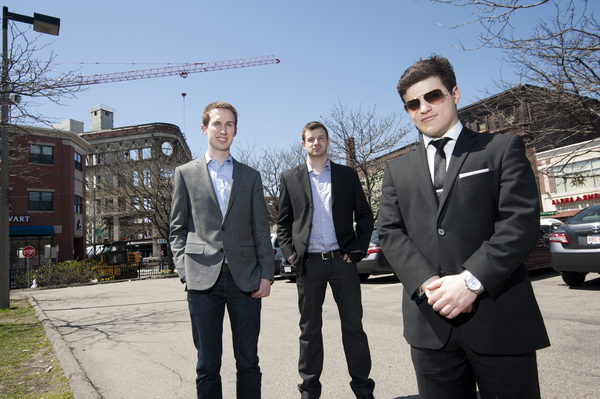Students have development ideas for Dudley Square

There’s very little on this Dudley Square lot in Boston’s Roxbury neighborhood. But a trio of architecture students sees a future where the parcel between Washington Street and Harrison Avenue could one day accommodate luxury housing, small lofts for recent college graduates, and family residences inspired by Boston’s iconic multifamily row houses, creating new opportunities and prosperity for a neighborhood in flux.
The model doesn’t just apply to Dudley Square either, though the students have presented their proposal to professional architects and developers planning projects in this up-and-coming area of Boston; the space will soon feature a new municipal building and is close to major employers like Boston Medical Center and educational hubs such as Northeastern. Fifth-year architecture students Ryan Matthew, Chris Marciano, and Mark Munroe believe their design could help develop new areas with a diverse group of residents.
“You can’t just saturate a community with one particular type of resident,” said Marciano. “When you have an area with a number of different backgrounds, you create an environment where everyone benefits from the presence of everyone else.”
The trio’s proposal, which they call the Blair Residences, focused on creating a high-density housing environment without overcrowding. The plan’s design included limiting the number of each building’s utility areas by placing bathrooms and kitchens in close proximity. It also incorporated common space and parking, key factors in high-quality living.
The three components of the Blair Residents—single-resident lofts designed by Marciano, luxury units designed by Matthew, and family homes designed by Munroe—create a housing environment that meets the needs of higher-salaried workers, recent college graduates looking for an affordable one-bedroom space (which are few and far between in and around Boston), and families already living in Dudley Square or nearby.
The students completed the Blair Resident project this fall in the School of Architecture’s Housing Design Studio class taught by lecturer Jonathan Evans, the senior designer for downtown architecture firm Utile. Their work represented just one project of about a dozen created by students, each of whom brought unique perspectives to reshaping the neighborhood. Much of the work was presented at RISE, the university’s annual research and scholarship exposition held in March.
“It can be different to find opportunities for innovation in these market-driven building types,” Evans said. “But our students manage to design prototypes and apply them in a real-world context. There’s something very projective—even utopian—about developing a strategy for a specific site that could also be taken elsewhere.”
Boston, like urban areas across the country, desperately needs new housing stock—and not just the luxury units that have popped up across the city in recent years. Last year’s Greater Boston Housing Report Card, an annual publication released by the Dukakis Center, an urban studies think tank within Northeastern’s School of Public Policy and Urban Affairs, said the city needs to add 12,000 new units of housing every year to simply meet demand; Boston added only about 6,000 new units per year between 2005 and 2011, creating an enormous demand for housing.
Dudley Square is already a transit hub, and proposed development is leading officials to consider new transportation options, such as an extension of the Silver Line, a rapid bus network that supplements the Massachusetts Bay Transportation Authority’s existing train and bus service.
“Dudley is a neighborhood with a rich history,” Marciano said. “Its location and new development are already bringing in new jobs and drawing people there, so we need housing options that will support that growth.”
This mixed-use model can support growth in cities across the United States, an enormous number of which need not only new housing options, but also the ability to meet the needs of a diverse cohort of potential residents.
“This is a project that could be applied to cities all over the U.S., and even beyond,” Munroe said.
Click the images below to see renderings of the buildings designed by Matthew, Munroe, and Marciano.








